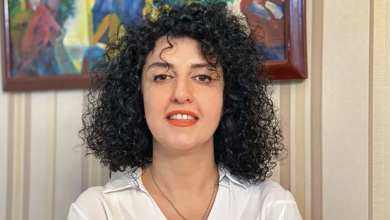Qisas: A Law for Injustice
The Case of Fatemeh
Fatemeh was born on November 8, 1991. On April 19, 2009, only seven months before her eighteenth birthday, she was charged with the murder of her second husband. At the age of 15, Fatemeh had been forced by her family to marry her first husband. That marriage only lasted 15 days, during which she was beaten several times. The couple eventually decided to separate. Not long after her divorce, Fatemeh’s family decided to erase the shame of Fatemeh’s failed first marriage and forced her again to marry. They believed that in their small town environment, their once-divorced daughter would not have a chance to marry a suitable man. With this in mind, they found an employed maternal relative and forced her to get married for the second time. None of her protests or objections worked. No one paid any attention to her needs.
Fatemeh, who was a student at the time, did not agree to live with her legally-wedded husband, with whom she never had a good relationship. Her husband lived in a room in a mosque, and every once in a while, Fatemeh would visit him in the mosque. Some of these visits ended in arguments between the two. These arguments were so loud that the cleric and custodian of the mosque could hear them.
In April 2009, Fatemeh’s husband was found dead in his room. The police immediately launched a search for Fatemeh and she was found in the library of her school.
One day after the incident and her arrest, the police began to interrogate her without the presence of a [defense] lawyer. They did not grant her permission to employ an attorney. Early on, at the police station, she admitted to the crime. But later in court, where she had a lawyer present, she denied the charges and announced that her confession was based on fear and ignorance of the system.
She emphatically denied the charge of the first-degree murder of her husband and declared that she had had no motive to kill him. But her objection to the forced marriage and her refusal to engage in the [marital] relationship gave the court sufficient reason to put an end to further investigations into the case [which could have found further exculpatory evidence]. As a result, Fatemeh has been in detention for more than six years now.
At the end of her first and only hearing, according to Article 206 of the Islamic Penal Code ratified in 1991, Fatemeh was sentenced to qisas nafs (qisas that results in the death of the convicted individual). Despite denying the charges throughout the hearing, she was sentenced to death. Her denial and her lawyer’s defence had no impact on the judge’s decision, nor did her age (seventeen at the time of the alleged murder), or the fact that she had been deprived of a defense lawyer at the outset of her arrest. She was sentenced to death in April/May of 2010 based only on her confession on the second day of her arrest, when she was still being deprived of access to counsel.
Fatemeh’s lawyer’s subsequent request for an appeal did not result in a reversal of the trial court decision, and four months thereafter the Supreme Court of Iran approved the imposition of the death penalty. After this, in order for the death sentence to be carried out, her file was sent to the Bureau for the Enforcement of Judgments on first-degree murder charges [these Bureaus for the Enforcement of Judgments are local offices of the judiciary throughout the country that are tasked with taking the administrative steps relating to the imposition of punishments after criminal sentences are finalized]. The sentence was then sent to the Head of the Judiciary, who in turn approved of the death penalty.
The only remaining hope for Fatemeh was to be granted a pardon by the victim’s family. Many attempts were made to secure a pardon for Fatemeh, but they were all turned down by her husband’s family.
Hope was gradually lost as despair and anxiety overwhelmed Fatemeh and her family, and Fatemeh went into a deep depression.
The Human Rights Council of the Judiciary and the National Authority on the Rights of the Child were both informed of Fatemeh’s situation. Although she was charged with a crime that she allegedly committed as a minor, and was indeed sentenced to death as a minor, they have paid no heed to the case and have done nothing to stay her execution.
The View of the Islamic Penal Code…
With the promulgation of the new Islamic Penal Code in 2013, the Islamic Republic of Iran (IRI) claims to have put a stop to the executions of those who commit crimes punishable by hudud (punishments based on the Quran or Hadith) or qisas (retaliatory punishments) before the age of eighteen. This claim is not completely unfounded, since Article 91 of the New Code makes mention of the above improvement to the law. However, a closer look at the content of sections of this same law reveals that in practice, not much has changed and the execution of young offenders has not been completely abolished. [1]
Chapter 10 of Book II of the Islamic Penal Code says that young offenders are not to be punished by execution. However, the majority of crimes mentioned in that chapter are punishable by ta’zir, a category of Shari’a punishments that allows for substantial judicial discretion in determining the manner and severity of punishment. Such crimes are based on Islamic rules, but the specifics of the penalties are determined by the judge, and the majority of crimes enumerated therein are less serious crimes that are not punishable by death or life imprisonment. As to crimes punishable by hudud or qisas, however, the same chapter only considers girls under the age of nine lunar years and boys under the age of 15 lunar years as underage minors [meaning anyone accused of committing a capital crime over those minimums can be subject to the death penalty as well under this provision].
Thus, upon reflection it is clearly evident that the new developments in Chapter 10 and Article 91 of the Islamic Penal Code have little or no impact on the [positive] fate of young offenders. Furthermore, articles 146 and 147 of the [same] Code explicitly establish the age of criminal responsibility is indicated as a full 9 lunar years for girls and a full 15 lunar years for boys. [2]
The Case of Fatemeh, Continued…
It does appear as though the provisions in Chapter 10 of Book II of the Penal Code reflect some recent improvements in laws pertaining to young offenders. But upon exploring Fatemeh’s file, it becomes evident that legislators in Iran do not intend to forego Shari’a Law in such cases. Otherwise, why would the law discriminate between girls and boys? There is no practical reason for the six-year difference between the social and legal responsibilities of girls and boys, whereby girls are criminally responsible at nine lunar years of age and boys at 15 lunar years. Therefore, based on the Law, at this point a request for an extraordinary procedural review of the case was the only sure way to delay Fatemeh’s impending execution.
As a result, Fatemeh’s execution order was stayed by Branch 14 of the Supreme Court due to the request for an extraordinary procedural review on September 21, 2013. Her age was discussed in the Supreme Court’s order and on that basis, the execution order of May 2010 was overturned pursuant to the stipulations of Article 91 of the Islamic Penal Code. But the case did not end there–another court that was given the duty of reviewing her file paid heed neither to her lawyer’s defense, nor to the reasons for the Supreme Court’s reversal of the death sentence. As a result, in May of 2014, under to Article 206 of the old Islamic Penal Code and Article 290 of the new Islamic Penal Code, and at the request of the victim’s family, Fatemeh was again sentenced to death by the second trial court, which ignored Fatemeh’s age at the time of the crime primarily because that the judges [in the initial trial] had sentenced her to qisas nafs, and also because Shari’a designates the age of criminal responsibility for girls to be nine lunar years.
In re-issuing the death sentence, the second court reasoned that Fatemeh’s mental and emotional state [at time of the crime] allowed her to make an informed decision, that she knew what she was doing and was quite aware of the consequence of the crime that she [allegedly] committed when she committed it, and that the coroner had testified as to Fatemeh’s sanity. This decision of the court demonstrates the arrogance of some Islamic countries, where sentencing children to death is justified only on the basis of Shari’a with the excuse that the children so sentenced are of sane mind, while the rest of the world, plainly recognizes 18 as the age of maturity.
Fatemeh’s defense lawyer objected to the death penalty based on the fact that at the time of the crime Fatemeh was only 17 and because Article 37, Section (a) of the UN Convention on the Rights of the Child establishes that “no child should be subjected to capital punishment.” The defense lawyer also argued that the necessary investigations had not been carried out and Fatemeh’s original confession had been extracted under duress and without the presence of her lawyer and therefore the death penalty should be annulled. Both of these arguments were rejected by the court. [3]
Statutory Context
The insistence of [Iran’s] legislators and judges on implementing the laws of hudud and qisas without regard for its obligations under the CRC is [apparently] motivated by their eagerness to carry out Shari’a. This insistence represents a total disregard of all the international obligations that Iran accepted when it ratified the International Covenant on Civil and Political Rights. Since Iran joined the Covenant with no provisions or conditions, then it must adhere to Article 6, Section 5, which clearly prohibits the execution of offenders under the age of 18. [4]
The Islamic Republic’s commitment to the provisions of the Covenant is not subject to debate or derogation, and Iran is bound to consider the above provisions when legislating and executing laws. The Covenant also explicitly states that that nothing in its text can be interpreted in any way that would diminish the rights and freedoms recognized therein, or create any form of discrimination. [5] But Fatemeh’s case and thousands of others clearly establish the Islamic Republic’s gross and systematic breach of its commitments to the Covenant.
What is evident is that, in practice, legislation of important criminal and penal laws, such as first-degree murder laws, don’t mean anything. Because all of the above laws are, in one way or another, interpretations of Islamic laws accepted by the country’s religious leaders and not based on society’s need for justice and equality [as under a more positivist model of lawmaking]. Upon exploring the most recent legislation in Iran, as well as Fatemeh’s file, one can only conclude that the faulty and unjust Islamic Penal Code [of Iran] has not undergone any considerable reform.
In spite of the many promises of “freedom and equality for all” made by the leaders during the [1979] Revolution, the day after its victory it became evident that all social and legal relations and regulations in Iran were to be governed by Islamic laws. This remains the case to this day, with no exception.
The problem of Hudud and Qisas has been a great challenge to the country’s penal laws since 1979. In the last three decades, not one day has gone by without a Hudud or Qisas order or execution being discussed or challenged in Iranian society.
Despite opposition from legal advisors, well-known political activists, and the Iranian Bar Association, Iranians face the gallows for different reasons on a daily basis [6].
In its attempt to “Islamize” Iran’s legal and judicial system, the Supreme Judicial Council (Shoraye Ali Ghazai) of the time first introduced the Hudud and Qisas Law in the early 1980s under the title Hudud and Qisas Act. Interestingly, this Act has not yet turned into permanent law. In the beginning, on August 25, 1982, the Act was introduced as a pilot legislation, to be reviewed every five years. It has so far been ratified twice—in 1991/1992 and 2012/2013—each time as an experimental legislation. This is, of course, not surprising since the Act has never been based on social needs, it has not helped reduce the crime rate, and has very negatively impacted the country’s development and security.
The characteristics of this Act and the insistence of the Government to execute Sharia Law have gradually resulted in the [Islamic] law permeating all levels of Iranian society. Law schools throughout the country teach and discuss the law of Qisas, many books and theses are written exploring the merits of the Act and its [Islamic] basis from its proponents’ point of view, while its opponents, including lawyers and attorneys, are being prosecuted and imprisoned.
Conclusion
In short, one can unequivocally and emphatically say that the Law of Qisas will never safeguard justice [in Iran] for the following reasons:
The law of Qisas is founded on a serious violation of human rights because it promotes personal revenge and fosters indifference towards the conditions of the crime and the subsequent interrogation, as well as the offender’s personality, mental health status and age (9 being the age of criminal responsibility for girls and 15 for boys). In the case of Fatemeh, too, we see that even if she had committed the crime, the court failed to pay any attention to the poor emotional state brought on by her forced marriage at a very young and vulnerable age. The court completely failed to consider Fatemeh’s condition and in the end, she was dealt with very unjustly.
This Law consists of very clear forms of discrimination such as gender discrimination, a husband’s right to kill his unfaithful wife (Murder in Bed), discrimination against adherents of religions not recognized in the Constitution, relational discrimination (father and paternal grandfather have the right to kill their child or grandchild), or discrimination based on the mental health of the victim (the murder of an insane person is not punishable) [7].
In Qisas, proof of guilt is not scientific and does not lend itself to a fair hearing. It can ultimately lead to proof of guilt despite “reasonable doubt” [8].
Qisas is, in reality, the right of the victim’s family [to take revenge]. It is not a legal act designed to punish a dangerous offender in order to protect society. In this light, the plaintiff and the victim’s family play a crucial role first in determining the verdict, and once the defendant has been found guilty, in determining [the severity of] the punishment. Therefore, only those [offenders] who have the power and means to either pay the plaintiff off or to bully them into withdrawing their request for Qisas will be able to flee the sentence [9].
Qisas fosters and promotes violence and injustice among people and pits members of society against each other.
According to the law, the punishment for first degree murder and second degree murder is the same. Both types of offenders—those who commit premeditated murder and those who cause death in a sudden and non-premeditated manner—are sentenced to death. According to the Islamic Penal Code, all three classes of intentional homicide receive the same sentence [10].
Children under the age of 18 are subjected to punishment by death.
Qisas dictates the order of the court. The court of law becomes a battleground for the victim’s family and the defendant. Under these conditions, it is not unusual for the prosecutor to [side with the plaintiff and] limit the defendant’s right to a defense lawyer.
The Law of Qisas strips society of justice, the ability to improve the law, and the opportunity to receive fair trials.
Qisas is a tool that allows the Islamic Republic to show off its power, particularly with respect to public display of punishment, and systemic and political violence.
Lastly, although there are no accurate statistics on murder rates in Iran, it is quite evident that Qisas does not reduce crime and does not create legal security for its citizens.
Hossein Raeesi
Attorney, Human Rights Researcher
Footnotes:
1. Article 91 of the Penal Code passed in 2013 states,“In the cases of offenses punishable by hadd or qisas, if mature people under eighteen years do not realize the nature of the crime committed or its prohibition, or of there is uncertainty about their full mental development, according to their age, they shall be sentenced to the punishments prescribed in this chapter.
2. Id., Article 146- Non-mature children have no criminal responsibility.
Article 147- The age of maturity for girls and boys are, respectively, a full nine and fifteen lunar years.
3. All signing states of the CRC must adhere to the following provision:
Article 37 of the UN Convention on the Rights of the Child: (a) No child shall be subjected to torture or other cruel, inhuman or degrading treatment or punishment. Neither capital punishment nor life imprisonment without possibility of release shall be imposed for offences committed by persons below eighteen years of age.
4. Article 6 of International Covenant on Civil and Political Rights: 5) Sentence of death shall not be imposed for crimes committed by persons below eighteen years of age and shall not be carried out on pregnant women.
Id., Article 5:
1) Nothing in the present Covenant may be interpreted as implying for any State, group or person any right to engage in any activity or perform any act aimed at the destruction of any of the rights and freedoms recognized herein or at their limitation to a greater extent than is provided for in the present Covenant.
2) There shall be no restriction upon or derogation from any of the fundamental human rights recognized or existing in any State Party to the present Covenant pursuant to law, conventions, regulations or custom on the pretext that the present Covenant does not recognize such rights or that it recognizes them to a lesser extent.
6. For more information refer to the article on the Law of Qisas by Mohammad Hossein Nayyeri, available at http://www.iranhrdc.org/persian/permalink/3500.html#.VeXf9_lVhBc.
7. Articles 301 and 302 of Islamic Penal Code.
8. Id., Articles 312 to 349.
9. Id., Articles 347 to 367.
10. Id., Article 290.









